Auditing and Assurance Report: Inventory, Intangibles, and ASA 701
VerifiedAdded on 2020/10/22
|10
|3184
|187
Report
AI Summary
This auditing and assurance report analyzes the audit of Computing Solutions Limited, focusing on inventory and intangible assets. Task 1 examines inventory assertions (completeness and cut-off), identifying risks and substantive audit procedures like physical inventory counts and account analysis. The report also explains ASA 701 on communicating key audit matters. Task 2 addresses intellectual property, identifying occurrence and completeness risks, and suggests substantive procedures. The report emphasizes the importance of accurate financial statements and the auditor's role in ensuring their reliability, particularly regarding inventory management and intangible asset valuation. The report also highlights the importance of the ASA 701 standard in communicating key audit matters within the auditor's report. The report discusses the importance of physical inventory counts, and analysis of accounts receivable and payable. The second part of the report deals with intangible assets and the related assertions.
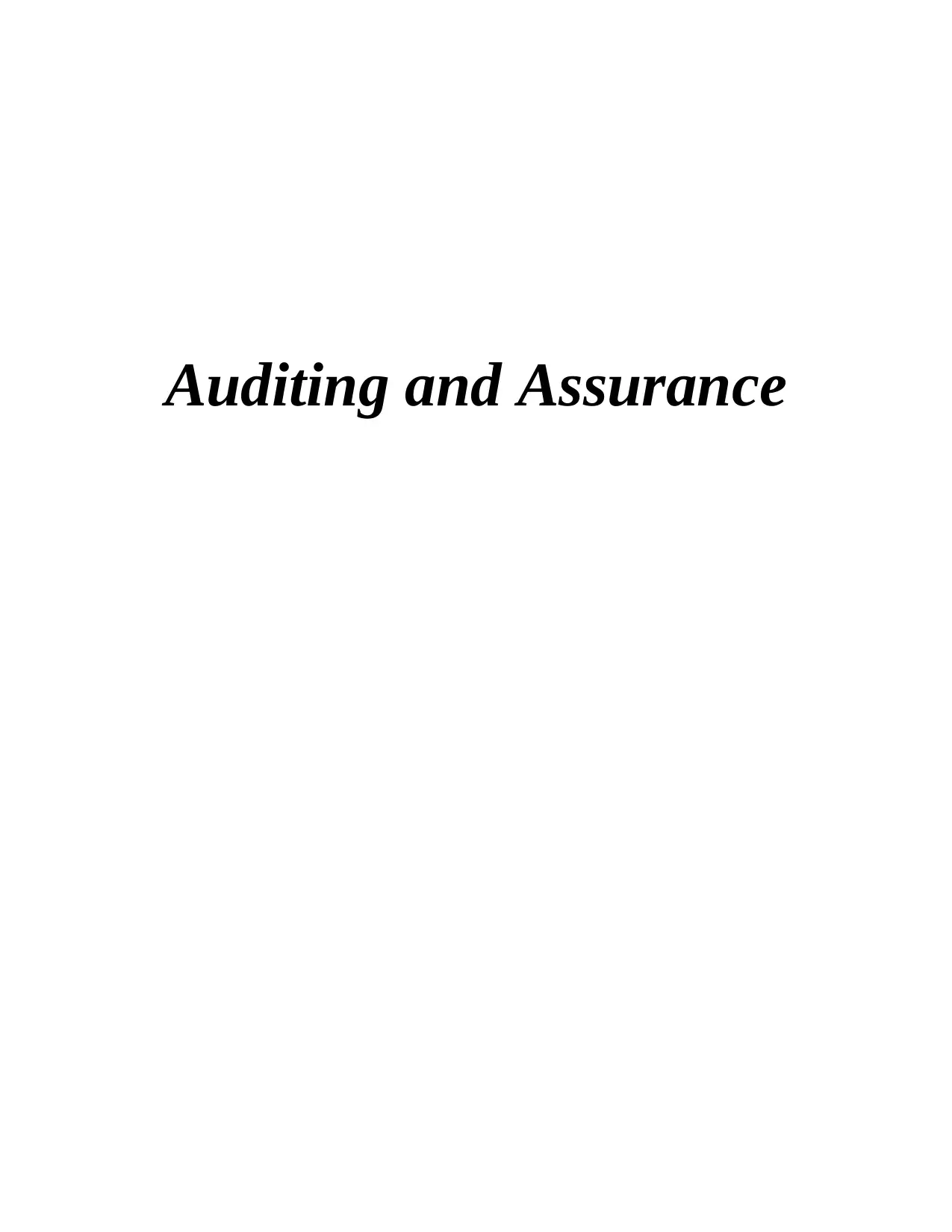
Auditing and Assurance
Paraphrase This Document
Need a fresh take? Get an instant paraphrase of this document with our AI Paraphraser
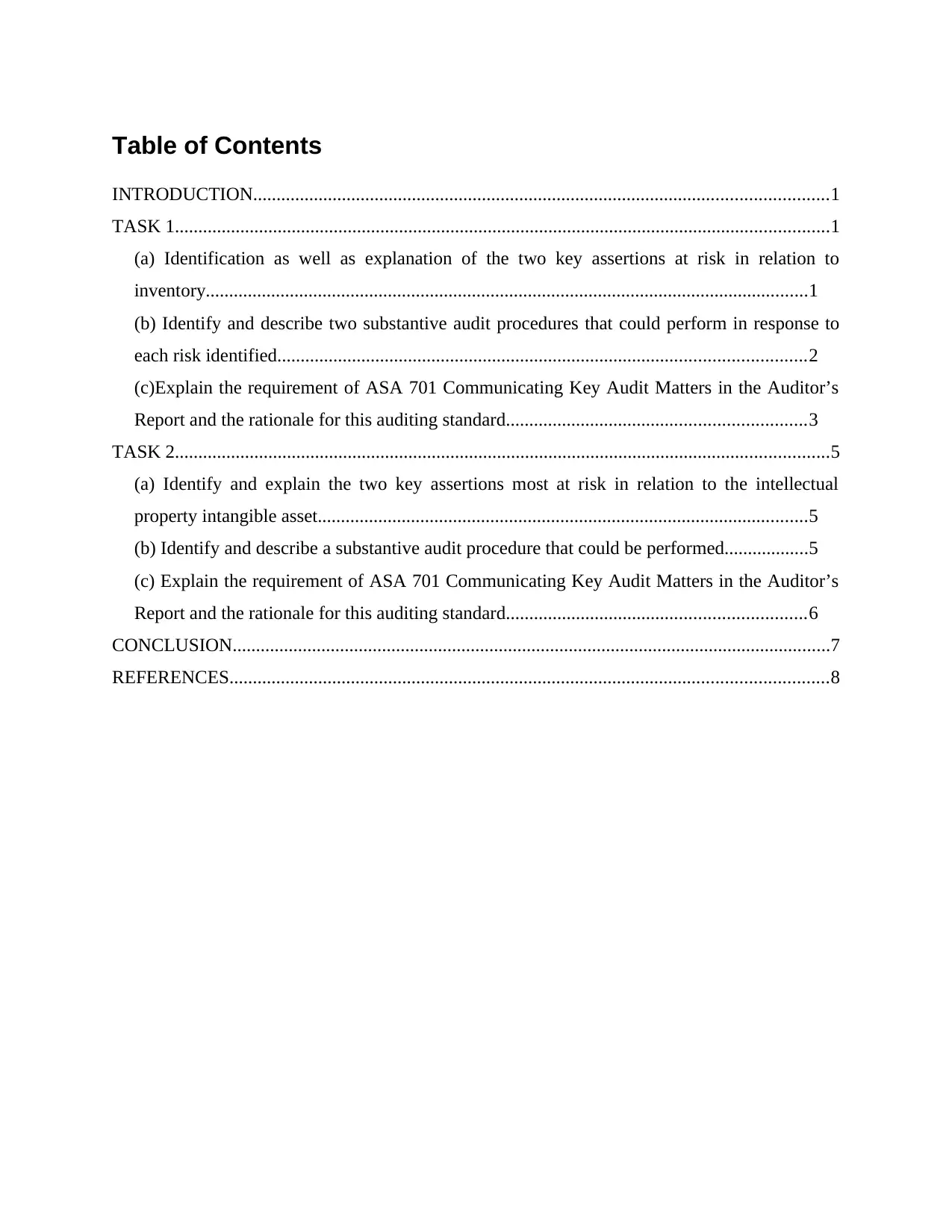
Table of Contents
INTRODUCTION...........................................................................................................................1
TASK 1............................................................................................................................................1
(a) Identification as well as explanation of the two key assertions at risk in relation to
inventory.................................................................................................................................1
(b) Identify and describe two substantive audit procedures that could perform in response to
each risk identified.................................................................................................................2
(c)Explain the requirement of ASA 701 Communicating Key Audit Matters in the Auditor’s
Report and the rationale for this auditing standard................................................................3
TASK 2............................................................................................................................................5
(a) Identify and explain the two key assertions most at risk in relation to the intellectual
property intangible asset.........................................................................................................5
(b) Identify and describe a substantive audit procedure that could be performed..................5
(c) Explain the requirement of ASA 701 Communicating Key Audit Matters in the Auditor’s
Report and the rationale for this auditing standard................................................................6
CONCLUSION................................................................................................................................7
REFERENCES................................................................................................................................8
INTRODUCTION...........................................................................................................................1
TASK 1............................................................................................................................................1
(a) Identification as well as explanation of the two key assertions at risk in relation to
inventory.................................................................................................................................1
(b) Identify and describe two substantive audit procedures that could perform in response to
each risk identified.................................................................................................................2
(c)Explain the requirement of ASA 701 Communicating Key Audit Matters in the Auditor’s
Report and the rationale for this auditing standard................................................................3
TASK 2............................................................................................................................................5
(a) Identify and explain the two key assertions most at risk in relation to the intellectual
property intangible asset.........................................................................................................5
(b) Identify and describe a substantive audit procedure that could be performed..................5
(c) Explain the requirement of ASA 701 Communicating Key Audit Matters in the Auditor’s
Report and the rationale for this auditing standard................................................................6
CONCLUSION................................................................................................................................7
REFERENCES................................................................................................................................8
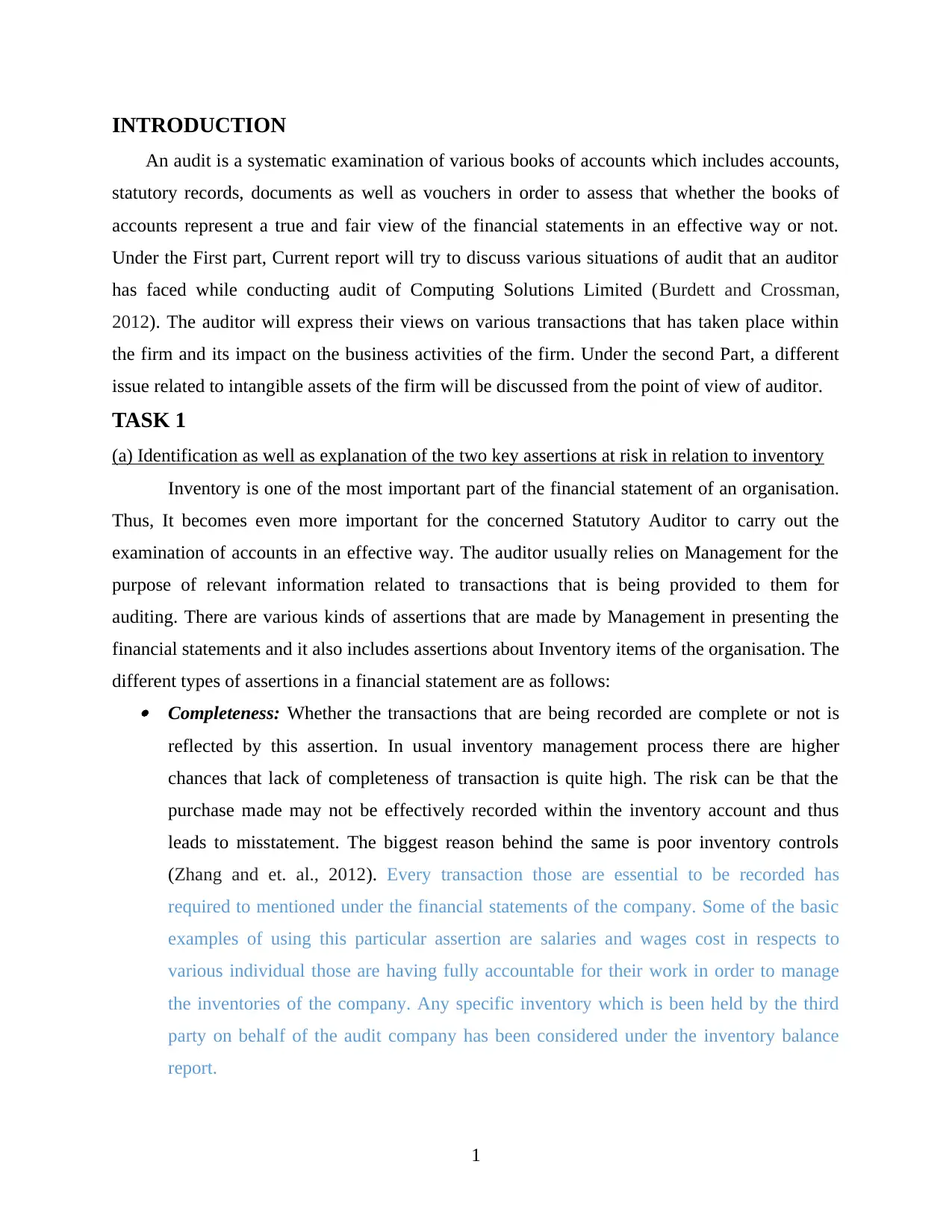
INTRODUCTION
An audit is a systematic examination of various books of accounts which includes accounts,
statutory records, documents as well as vouchers in order to assess that whether the books of
accounts represent a true and fair view of the financial statements in an effective way or not.
Under the First part, Current report will try to discuss various situations of audit that an auditor
has faced while conducting audit of Computing Solutions Limited (Burdett and Crossman,
2012). The auditor will express their views on various transactions that has taken place within
the firm and its impact on the business activities of the firm. Under the second Part, a different
issue related to intangible assets of the firm will be discussed from the point of view of auditor.
TASK 1
(a) Identification as well as explanation of the two key assertions at risk in relation to inventory
Inventory is one of the most important part of the financial statement of an organisation.
Thus, It becomes even more important for the concerned Statutory Auditor to carry out the
examination of accounts in an effective way. The auditor usually relies on Management for the
purpose of relevant information related to transactions that is being provided to them for
auditing. There are various kinds of assertions that are made by Management in presenting the
financial statements and it also includes assertions about Inventory items of the organisation. The
different types of assertions in a financial statement are as follows: Completeness: Whether the transactions that are being recorded are complete or not is
reflected by this assertion. In usual inventory management process there are higher
chances that lack of completeness of transaction is quite high. The risk can be that the
purchase made may not be effectively recorded within the inventory account and thus
leads to misstatement. The biggest reason behind the same is poor inventory controls
(Zhang and et. al., 2012). Every transaction those are essential to be recorded has
required to mentioned under the financial statements of the company. Some of the basic
examples of using this particular assertion are salaries and wages cost in respects to
various individual those are having fully accountable for their work in order to manage
the inventories of the company. Any specific inventory which is been held by the third
party on behalf of the audit company has been considered under the inventory balance
report.
1
An audit is a systematic examination of various books of accounts which includes accounts,
statutory records, documents as well as vouchers in order to assess that whether the books of
accounts represent a true and fair view of the financial statements in an effective way or not.
Under the First part, Current report will try to discuss various situations of audit that an auditor
has faced while conducting audit of Computing Solutions Limited (Burdett and Crossman,
2012). The auditor will express their views on various transactions that has taken place within
the firm and its impact on the business activities of the firm. Under the second Part, a different
issue related to intangible assets of the firm will be discussed from the point of view of auditor.
TASK 1
(a) Identification as well as explanation of the two key assertions at risk in relation to inventory
Inventory is one of the most important part of the financial statement of an organisation.
Thus, It becomes even more important for the concerned Statutory Auditor to carry out the
examination of accounts in an effective way. The auditor usually relies on Management for the
purpose of relevant information related to transactions that is being provided to them for
auditing. There are various kinds of assertions that are made by Management in presenting the
financial statements and it also includes assertions about Inventory items of the organisation. The
different types of assertions in a financial statement are as follows: Completeness: Whether the transactions that are being recorded are complete or not is
reflected by this assertion. In usual inventory management process there are higher
chances that lack of completeness of transaction is quite high. The risk can be that the
purchase made may not be effectively recorded within the inventory account and thus
leads to misstatement. The biggest reason behind the same is poor inventory controls
(Zhang and et. al., 2012). Every transaction those are essential to be recorded has
required to mentioned under the financial statements of the company. Some of the basic
examples of using this particular assertion are salaries and wages cost in respects to
various individual those are having fully accountable for their work in order to manage
the inventories of the company. Any specific inventory which is been held by the third
party on behalf of the audit company has been considered under the inventory balance
report.
1
⊘ This is a preview!⊘
Do you want full access?
Subscribe today to unlock all pages.

Trusted by 1+ million students worldwide
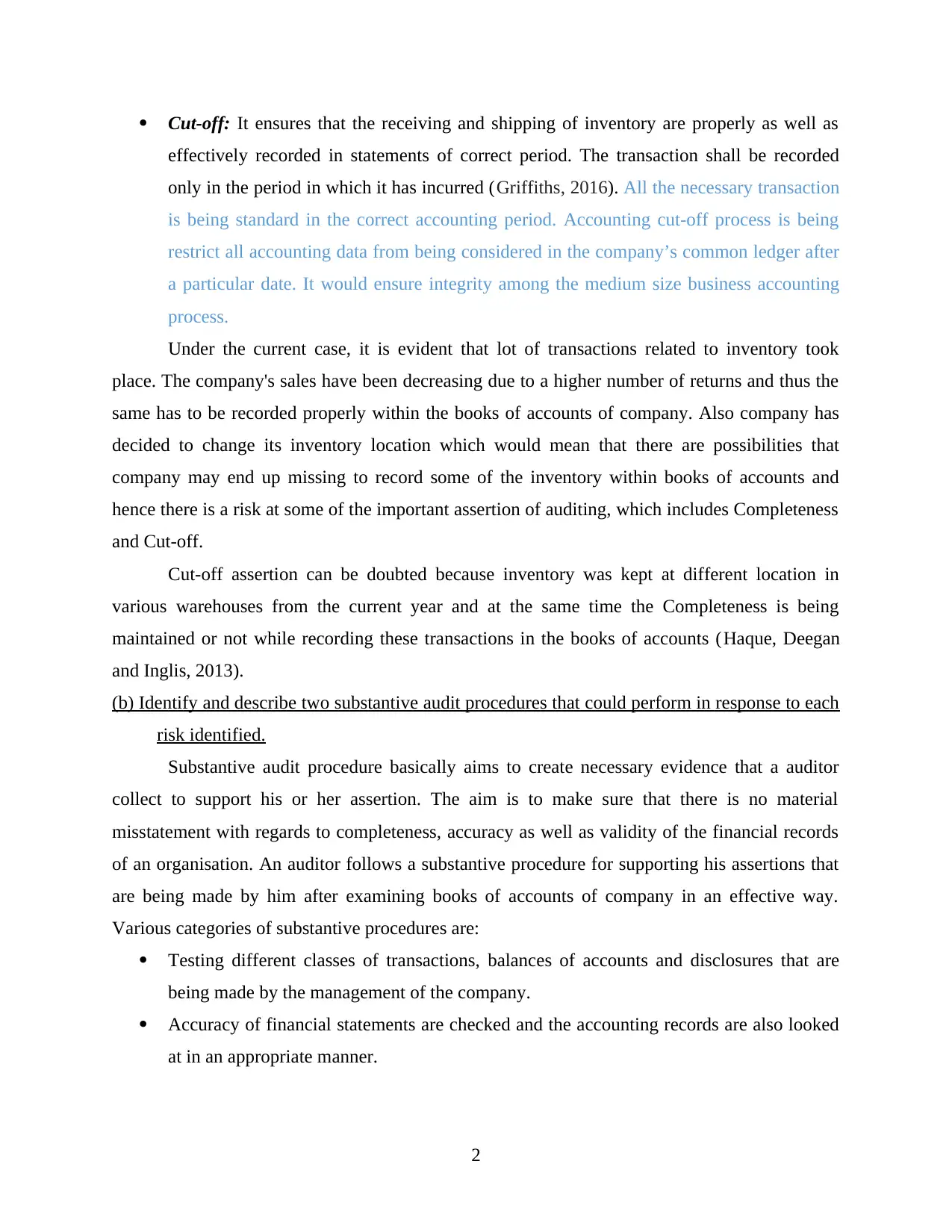
Cut-off: It ensures that the receiving and shipping of inventory are properly as well as
effectively recorded in statements of correct period. The transaction shall be recorded
only in the period in which it has incurred (Griffiths, 2016). All the necessary transaction
is being standard in the correct accounting period. Accounting cut-off process is being
restrict all accounting data from being considered in the company’s common ledger after
a particular date. It would ensure integrity among the medium size business accounting
process.
Under the current case, it is evident that lot of transactions related to inventory took
place. The company's sales have been decreasing due to a higher number of returns and thus the
same has to be recorded properly within the books of accounts of company. Also company has
decided to change its inventory location which would mean that there are possibilities that
company may end up missing to record some of the inventory within books of accounts and
hence there is a risk at some of the important assertion of auditing, which includes Completeness
and Cut-off.
Cut-off assertion can be doubted because inventory was kept at different location in
various warehouses from the current year and at the same time the Completeness is being
maintained or not while recording these transactions in the books of accounts (Haque, Deegan
and Inglis, 2013).
(b) Identify and describe two substantive audit procedures that could perform in response to each
risk identified.
Substantive audit procedure basically aims to create necessary evidence that a auditor
collect to support his or her assertion. The aim is to make sure that there is no material
misstatement with regards to completeness, accuracy as well as validity of the financial records
of an organisation. An auditor follows a substantive procedure for supporting his assertions that
are being made by him after examining books of accounts of company in an effective way.
Various categories of substantive procedures are:
Testing different classes of transactions, balances of accounts and disclosures that are
being made by the management of the company.
Accuracy of financial statements are checked and the accounting records are also looked
at in an appropriate manner.
2
effectively recorded in statements of correct period. The transaction shall be recorded
only in the period in which it has incurred (Griffiths, 2016). All the necessary transaction
is being standard in the correct accounting period. Accounting cut-off process is being
restrict all accounting data from being considered in the company’s common ledger after
a particular date. It would ensure integrity among the medium size business accounting
process.
Under the current case, it is evident that lot of transactions related to inventory took
place. The company's sales have been decreasing due to a higher number of returns and thus the
same has to be recorded properly within the books of accounts of company. Also company has
decided to change its inventory location which would mean that there are possibilities that
company may end up missing to record some of the inventory within books of accounts and
hence there is a risk at some of the important assertion of auditing, which includes Completeness
and Cut-off.
Cut-off assertion can be doubted because inventory was kept at different location in
various warehouses from the current year and at the same time the Completeness is being
maintained or not while recording these transactions in the books of accounts (Haque, Deegan
and Inglis, 2013).
(b) Identify and describe two substantive audit procedures that could perform in response to each
risk identified.
Substantive audit procedure basically aims to create necessary evidence that a auditor
collect to support his or her assertion. The aim is to make sure that there is no material
misstatement with regards to completeness, accuracy as well as validity of the financial records
of an organisation. An auditor follows a substantive procedure for supporting his assertions that
are being made by him after examining books of accounts of company in an effective way.
Various categories of substantive procedures are:
Testing different classes of transactions, balances of accounts and disclosures that are
being made by the management of the company.
Accuracy of financial statements are checked and the accounting records are also looked
at in an appropriate manner.
2
Paraphrase This Document
Need a fresh take? Get an instant paraphrase of this document with our AI Paraphraser
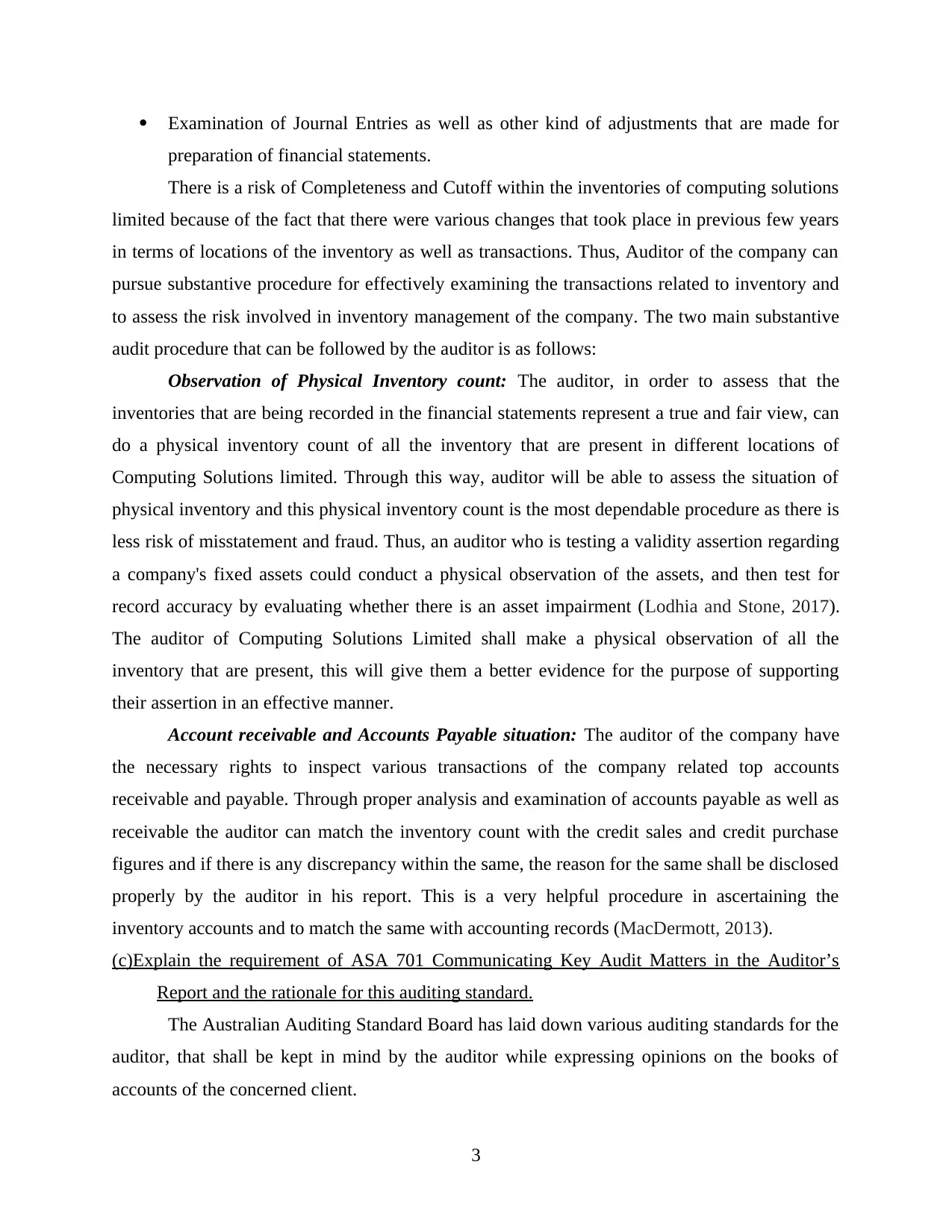
Examination of Journal Entries as well as other kind of adjustments that are made for
preparation of financial statements.
There is a risk of Completeness and Cutoff within the inventories of computing solutions
limited because of the fact that there were various changes that took place in previous few years
in terms of locations of the inventory as well as transactions. Thus, Auditor of the company can
pursue substantive procedure for effectively examining the transactions related to inventory and
to assess the risk involved in inventory management of the company. The two main substantive
audit procedure that can be followed by the auditor is as follows:
Observation of Physical Inventory count: The auditor, in order to assess that the
inventories that are being recorded in the financial statements represent a true and fair view, can
do a physical inventory count of all the inventory that are present in different locations of
Computing Solutions limited. Through this way, auditor will be able to assess the situation of
physical inventory and this physical inventory count is the most dependable procedure as there is
less risk of misstatement and fraud. Thus, an auditor who is testing a validity assertion regarding
a company's fixed assets could conduct a physical observation of the assets, and then test for
record accuracy by evaluating whether there is an asset impairment (Lodhia and Stone, 2017).
The auditor of Computing Solutions Limited shall make a physical observation of all the
inventory that are present, this will give them a better evidence for the purpose of supporting
their assertion in an effective manner.
Account receivable and Accounts Payable situation: The auditor of the company have
the necessary rights to inspect various transactions of the company related top accounts
receivable and payable. Through proper analysis and examination of accounts payable as well as
receivable the auditor can match the inventory count with the credit sales and credit purchase
figures and if there is any discrepancy within the same, the reason for the same shall be disclosed
properly by the auditor in his report. This is a very helpful procedure in ascertaining the
inventory accounts and to match the same with accounting records (MacDermott, 2013).
(c)Explain the requirement of ASA 701 Communicating Key Audit Matters in the Auditor’s
Report and the rationale for this auditing standard.
The Australian Auditing Standard Board has laid down various auditing standards for the
auditor, that shall be kept in mind by the auditor while expressing opinions on the books of
accounts of the concerned client.
3
preparation of financial statements.
There is a risk of Completeness and Cutoff within the inventories of computing solutions
limited because of the fact that there were various changes that took place in previous few years
in terms of locations of the inventory as well as transactions. Thus, Auditor of the company can
pursue substantive procedure for effectively examining the transactions related to inventory and
to assess the risk involved in inventory management of the company. The two main substantive
audit procedure that can be followed by the auditor is as follows:
Observation of Physical Inventory count: The auditor, in order to assess that the
inventories that are being recorded in the financial statements represent a true and fair view, can
do a physical inventory count of all the inventory that are present in different locations of
Computing Solutions limited. Through this way, auditor will be able to assess the situation of
physical inventory and this physical inventory count is the most dependable procedure as there is
less risk of misstatement and fraud. Thus, an auditor who is testing a validity assertion regarding
a company's fixed assets could conduct a physical observation of the assets, and then test for
record accuracy by evaluating whether there is an asset impairment (Lodhia and Stone, 2017).
The auditor of Computing Solutions Limited shall make a physical observation of all the
inventory that are present, this will give them a better evidence for the purpose of supporting
their assertion in an effective manner.
Account receivable and Accounts Payable situation: The auditor of the company have
the necessary rights to inspect various transactions of the company related top accounts
receivable and payable. Through proper analysis and examination of accounts payable as well as
receivable the auditor can match the inventory count with the credit sales and credit purchase
figures and if there is any discrepancy within the same, the reason for the same shall be disclosed
properly by the auditor in his report. This is a very helpful procedure in ascertaining the
inventory accounts and to match the same with accounting records (MacDermott, 2013).
(c)Explain the requirement of ASA 701 Communicating Key Audit Matters in the Auditor’s
Report and the rationale for this auditing standard.
The Australian Auditing Standard Board has laid down various auditing standards for the
auditor, that shall be kept in mind by the auditor while expressing opinions on the books of
accounts of the concerned client.
3

ASA 701
This is an auditing Standard that deals with the responsibility to communicate the key
audit matters within the auditor’s report. This standard has specified that what are the key audit
matters that needs to be specified and what matters needs to be ignored in preparing the audit
report. The form as well as content of such communication is also explained within the Standard.
Key Audit Matters refers to those matters that in auditor's professional judgement is of the most
significance in the audit of financial report and thus key audit matters shall be selected after
communicating with the people who are charged with governance (Zerni, 2012). Following
matters can be said to be as key audit matters that has to be presented within the audit report:
Areas of higher assessed risk of Material Misstatement Matters that basically involves a significant management judgement as well as
accounting estimates that carries high estimation uncertainty.
Determination of the Key Audit Matters
The concerned matter is not a key audit matter that need to be reflected into audit report
because it is a normal procedure in an IT firm that a software problem may occur and
hence return has to be made of the products.
This can be regarded as the Key audit matters because the inventory turnover of the
company has reduced substantially as compared to the previous years and it is important
that external users of the financial statements should have the knowledge of such change.
Changing warehousing location is an operational decision of the business and is not a key
audit matter that shall be reflected within books of accounts.
Inventory in Hand is also a matter which is not of such relevance that it should be
reflected within audit reports. It is a normal change and hence shall be ignored as key
matter by the auditor.
Bidding at a government auction at a considerable less price then competitors is also a
strategic business decision and until such bidding is causing higher losses to the company
and is a major concern for business performance of organisation, it shall not be reflected
within audit report.
4
This is an auditing Standard that deals with the responsibility to communicate the key
audit matters within the auditor’s report. This standard has specified that what are the key audit
matters that needs to be specified and what matters needs to be ignored in preparing the audit
report. The form as well as content of such communication is also explained within the Standard.
Key Audit Matters refers to those matters that in auditor's professional judgement is of the most
significance in the audit of financial report and thus key audit matters shall be selected after
communicating with the people who are charged with governance (Zerni, 2012). Following
matters can be said to be as key audit matters that has to be presented within the audit report:
Areas of higher assessed risk of Material Misstatement Matters that basically involves a significant management judgement as well as
accounting estimates that carries high estimation uncertainty.
Determination of the Key Audit Matters
The concerned matter is not a key audit matter that need to be reflected into audit report
because it is a normal procedure in an IT firm that a software problem may occur and
hence return has to be made of the products.
This can be regarded as the Key audit matters because the inventory turnover of the
company has reduced substantially as compared to the previous years and it is important
that external users of the financial statements should have the knowledge of such change.
Changing warehousing location is an operational decision of the business and is not a key
audit matter that shall be reflected within books of accounts.
Inventory in Hand is also a matter which is not of such relevance that it should be
reflected within audit reports. It is a normal change and hence shall be ignored as key
matter by the auditor.
Bidding at a government auction at a considerable less price then competitors is also a
strategic business decision and until such bidding is causing higher losses to the company
and is a major concern for business performance of organisation, it shall not be reflected
within audit report.
4
⊘ This is a preview!⊘
Do you want full access?
Subscribe today to unlock all pages.

Trusted by 1+ million students worldwide
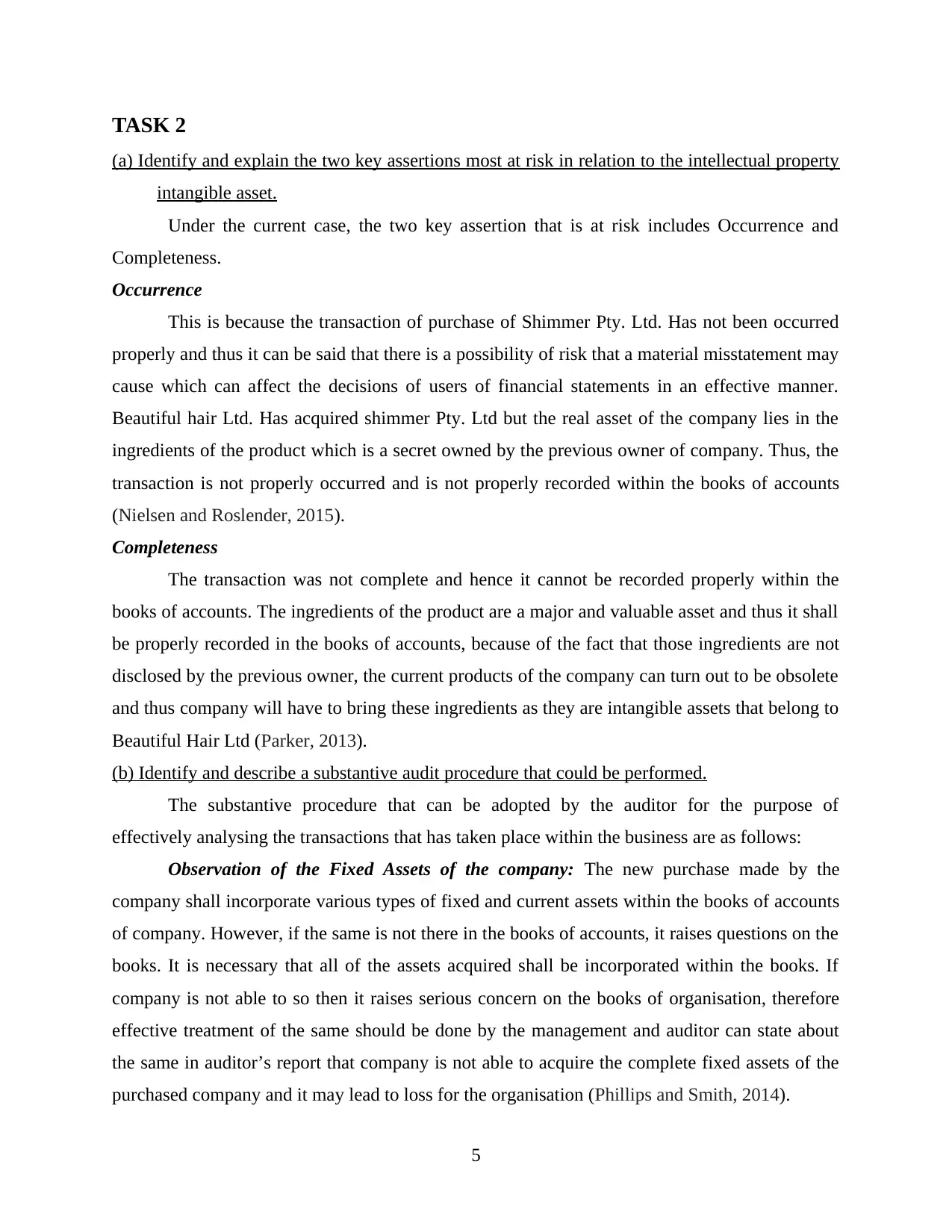
TASK 2
(a) Identify and explain the two key assertions most at risk in relation to the intellectual property
intangible asset.
Under the current case, the two key assertion that is at risk includes Occurrence and
Completeness.
Occurrence
This is because the transaction of purchase of Shimmer Pty. Ltd. Has not been occurred
properly and thus it can be said that there is a possibility of risk that a material misstatement may
cause which can affect the decisions of users of financial statements in an effective manner.
Beautiful hair Ltd. Has acquired shimmer Pty. Ltd but the real asset of the company lies in the
ingredients of the product which is a secret owned by the previous owner of company. Thus, the
transaction is not properly occurred and is not properly recorded within the books of accounts
(Nielsen and Roslender, 2015).
Completeness
The transaction was not complete and hence it cannot be recorded properly within the
books of accounts. The ingredients of the product are a major and valuable asset and thus it shall
be properly recorded in the books of accounts, because of the fact that those ingredients are not
disclosed by the previous owner, the current products of the company can turn out to be obsolete
and thus company will have to bring these ingredients as they are intangible assets that belong to
Beautiful Hair Ltd (Parker, 2013).
(b) Identify and describe a substantive audit procedure that could be performed.
The substantive procedure that can be adopted by the auditor for the purpose of
effectively analysing the transactions that has taken place within the business are as follows:
Observation of the Fixed Assets of the company: The new purchase made by the
company shall incorporate various types of fixed and current assets within the books of accounts
of company. However, if the same is not there in the books of accounts, it raises questions on the
books. It is necessary that all of the assets acquired shall be incorporated within the books. If
company is not able to so then it raises serious concern on the books of organisation, therefore
effective treatment of the same should be done by the management and auditor can state about
the same in auditor’s report that company is not able to acquire the complete fixed assets of the
purchased company and it may lead to loss for the organisation (Phillips and Smith, 2014).
5
(a) Identify and explain the two key assertions most at risk in relation to the intellectual property
intangible asset.
Under the current case, the two key assertion that is at risk includes Occurrence and
Completeness.
Occurrence
This is because the transaction of purchase of Shimmer Pty. Ltd. Has not been occurred
properly and thus it can be said that there is a possibility of risk that a material misstatement may
cause which can affect the decisions of users of financial statements in an effective manner.
Beautiful hair Ltd. Has acquired shimmer Pty. Ltd but the real asset of the company lies in the
ingredients of the product which is a secret owned by the previous owner of company. Thus, the
transaction is not properly occurred and is not properly recorded within the books of accounts
(Nielsen and Roslender, 2015).
Completeness
The transaction was not complete and hence it cannot be recorded properly within the
books of accounts. The ingredients of the product are a major and valuable asset and thus it shall
be properly recorded in the books of accounts, because of the fact that those ingredients are not
disclosed by the previous owner, the current products of the company can turn out to be obsolete
and thus company will have to bring these ingredients as they are intangible assets that belong to
Beautiful Hair Ltd (Parker, 2013).
(b) Identify and describe a substantive audit procedure that could be performed.
The substantive procedure that can be adopted by the auditor for the purpose of
effectively analysing the transactions that has taken place within the business are as follows:
Observation of the Fixed Assets of the company: The new purchase made by the
company shall incorporate various types of fixed and current assets within the books of accounts
of company. However, if the same is not there in the books of accounts, it raises questions on the
books. It is necessary that all of the assets acquired shall be incorporated within the books. If
company is not able to so then it raises serious concern on the books of organisation, therefore
effective treatment of the same should be done by the management and auditor can state about
the same in auditor’s report that company is not able to acquire the complete fixed assets of the
purchased company and it may lead to loss for the organisation (Phillips and Smith, 2014).
5
Paraphrase This Document
Need a fresh take? Get an instant paraphrase of this document with our AI Paraphraser
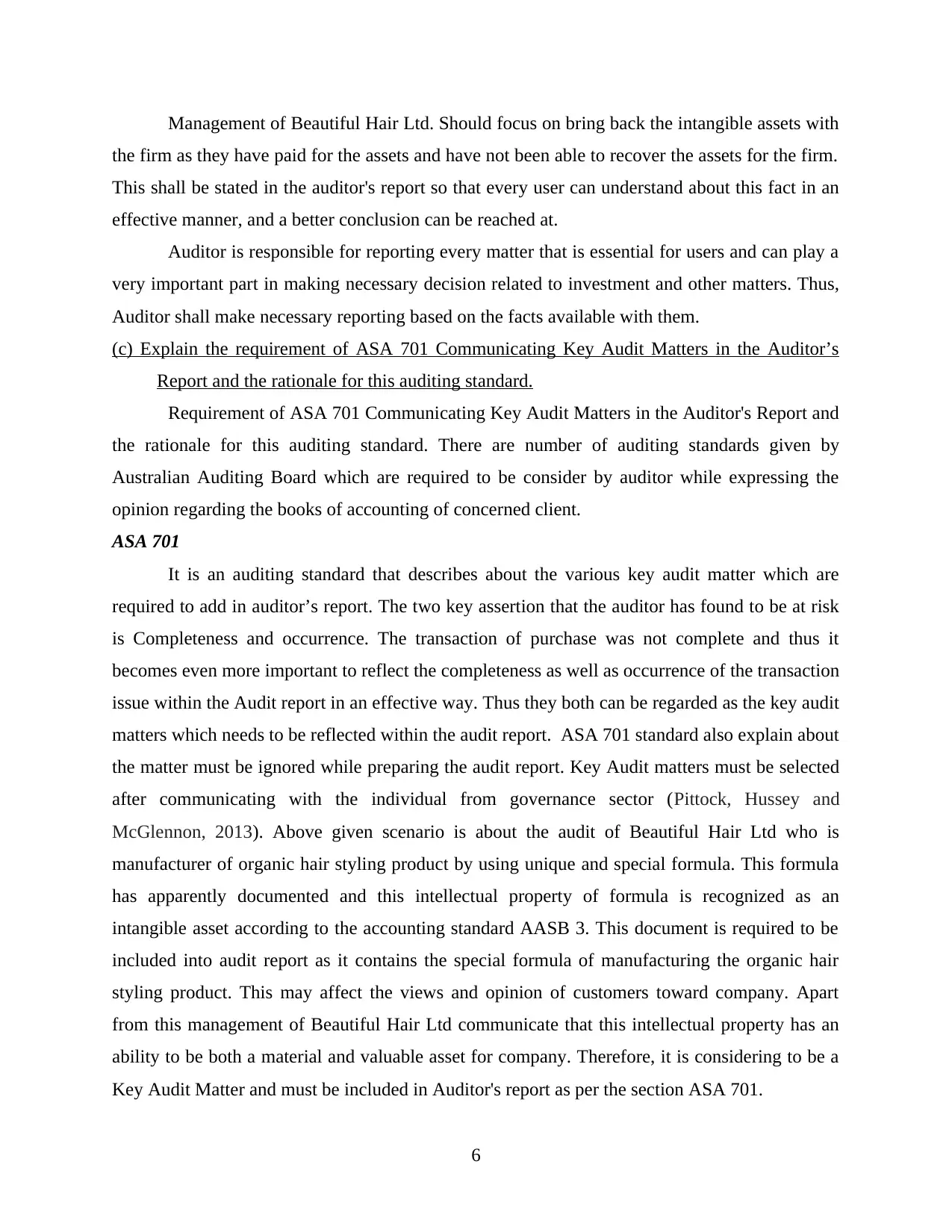
Management of Beautiful Hair Ltd. Should focus on bring back the intangible assets with
the firm as they have paid for the assets and have not been able to recover the assets for the firm.
This shall be stated in the auditor's report so that every user can understand about this fact in an
effective manner, and a better conclusion can be reached at.
Auditor is responsible for reporting every matter that is essential for users and can play a
very important part in making necessary decision related to investment and other matters. Thus,
Auditor shall make necessary reporting based on the facts available with them.
(c) Explain the requirement of ASA 701 Communicating Key Audit Matters in the Auditor’s
Report and the rationale for this auditing standard.
Requirement of ASA 701 Communicating Key Audit Matters in the Auditor's Report and
the rationale for this auditing standard. There are number of auditing standards given by
Australian Auditing Board which are required to be consider by auditor while expressing the
opinion regarding the books of accounting of concerned client.
ASA 701
It is an auditing standard that describes about the various key audit matter which are
required to add in auditor’s report. The two key assertion that the auditor has found to be at risk
is Completeness and occurrence. The transaction of purchase was not complete and thus it
becomes even more important to reflect the completeness as well as occurrence of the transaction
issue within the Audit report in an effective way. Thus they both can be regarded as the key audit
matters which needs to be reflected within the audit report. ASA 701 standard also explain about
the matter must be ignored while preparing the audit report. Key Audit matters must be selected
after communicating with the individual from governance sector (Pittock, Hussey and
McGlennon, 2013). Above given scenario is about the audit of Beautiful Hair Ltd who is
manufacturer of organic hair styling product by using unique and special formula. This formula
has apparently documented and this intellectual property of formula is recognized as an
intangible asset according to the accounting standard AASB 3. This document is required to be
included into audit report as it contains the special formula of manufacturing the organic hair
styling product. This may affect the views and opinion of customers toward company. Apart
from this management of Beautiful Hair Ltd communicate that this intellectual property has an
ability to be both a material and valuable asset for company. Therefore, it is considering to be a
Key Audit Matter and must be included in Auditor's report as per the section ASA 701.
6
the firm as they have paid for the assets and have not been able to recover the assets for the firm.
This shall be stated in the auditor's report so that every user can understand about this fact in an
effective manner, and a better conclusion can be reached at.
Auditor is responsible for reporting every matter that is essential for users and can play a
very important part in making necessary decision related to investment and other matters. Thus,
Auditor shall make necessary reporting based on the facts available with them.
(c) Explain the requirement of ASA 701 Communicating Key Audit Matters in the Auditor’s
Report and the rationale for this auditing standard.
Requirement of ASA 701 Communicating Key Audit Matters in the Auditor's Report and
the rationale for this auditing standard. There are number of auditing standards given by
Australian Auditing Board which are required to be consider by auditor while expressing the
opinion regarding the books of accounting of concerned client.
ASA 701
It is an auditing standard that describes about the various key audit matter which are
required to add in auditor’s report. The two key assertion that the auditor has found to be at risk
is Completeness and occurrence. The transaction of purchase was not complete and thus it
becomes even more important to reflect the completeness as well as occurrence of the transaction
issue within the Audit report in an effective way. Thus they both can be regarded as the key audit
matters which needs to be reflected within the audit report. ASA 701 standard also explain about
the matter must be ignored while preparing the audit report. Key Audit matters must be selected
after communicating with the individual from governance sector (Pittock, Hussey and
McGlennon, 2013). Above given scenario is about the audit of Beautiful Hair Ltd who is
manufacturer of organic hair styling product by using unique and special formula. This formula
has apparently documented and this intellectual property of formula is recognized as an
intangible asset according to the accounting standard AASB 3. This document is required to be
included into audit report as it contains the special formula of manufacturing the organic hair
styling product. This may affect the views and opinion of customers toward company. Apart
from this management of Beautiful Hair Ltd communicate that this intellectual property has an
ability to be both a material and valuable asset for company. Therefore, it is considering to be a
Key Audit Matter and must be included in Auditor's report as per the section ASA 701.
6

CONCLUSION
From the above report it can be concluded that it is highly essential to implement
necessary regulatory procedures that will allow better as well as effective management of the
firm. The auditors are responsible to give a fair and transparent view on the books of company
after an independent examination of the books in an efficient manner. It is necessary to
implement the necessary changes advised by the auditor to run business in an effective manner in
the longer run.
7
From the above report it can be concluded that it is highly essential to implement
necessary regulatory procedures that will allow better as well as effective management of the
firm. The auditors are responsible to give a fair and transparent view on the books of company
after an independent examination of the books in an efficient manner. It is necessary to
implement the necessary changes advised by the auditor to run business in an effective manner in
the longer run.
7
⊘ This is a preview!⊘
Do you want full access?
Subscribe today to unlock all pages.

Trusted by 1+ million students worldwide
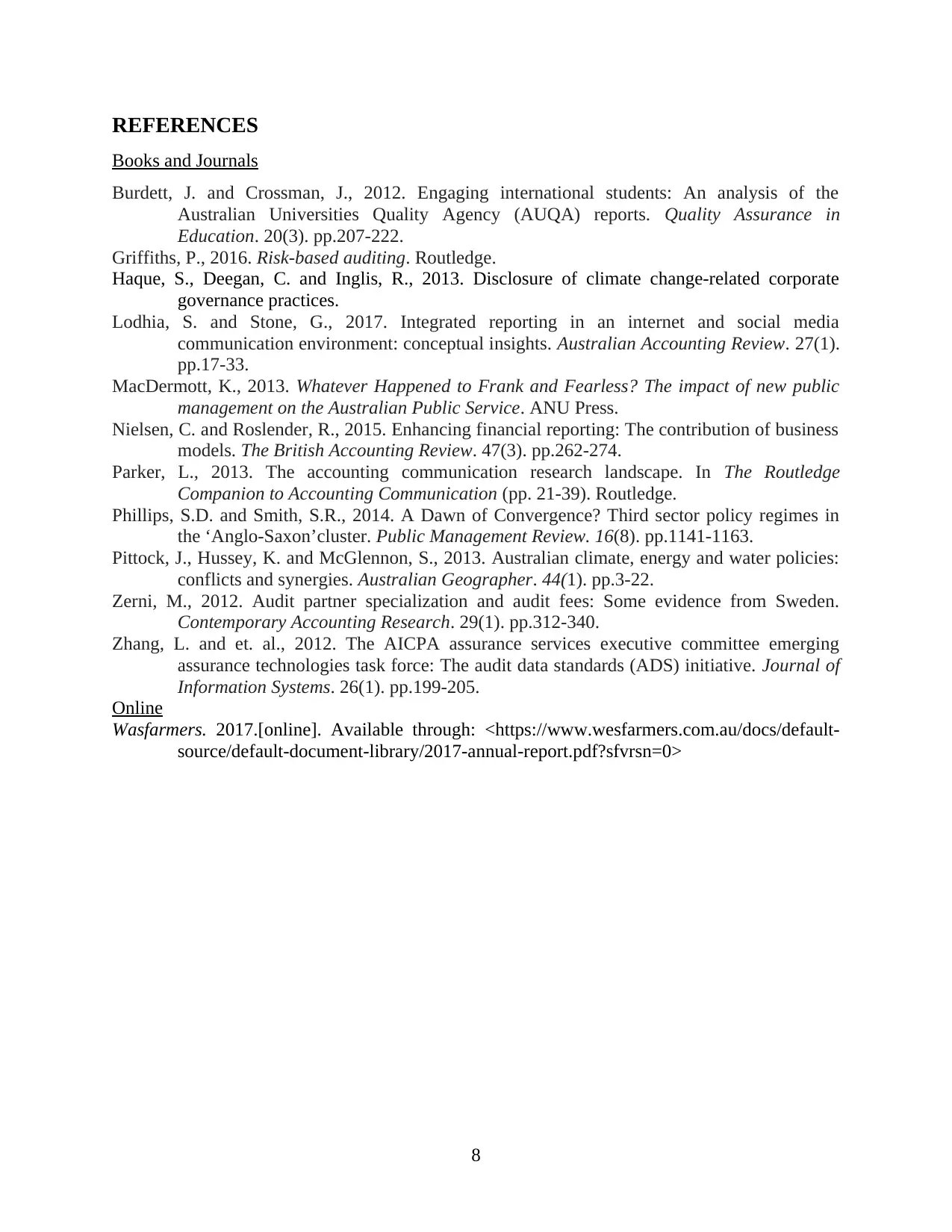
REFERENCES
Books and Journals
Burdett, J. and Crossman, J., 2012. Engaging international students: An analysis of the
Australian Universities Quality Agency (AUQA) reports. Quality Assurance in
Education. 20(3). pp.207-222.
Griffiths, P., 2016. Risk-based auditing. Routledge.
Haque, S., Deegan, C. and Inglis, R., 2013. Disclosure of climate change-related corporate
governance practices.
Lodhia, S. and Stone, G., 2017. Integrated reporting in an internet and social media
communication environment: conceptual insights. Australian Accounting Review. 27(1).
pp.17-33.
MacDermott, K., 2013. Whatever Happened to Frank and Fearless? The impact of new public
management on the Australian Public Service. ANU Press.
Nielsen, C. and Roslender, R., 2015. Enhancing financial reporting: The contribution of business
models. The British Accounting Review. 47(3). pp.262-274.
Parker, L., 2013. The accounting communication research landscape. In The Routledge
Companion to Accounting Communication (pp. 21-39). Routledge.
Phillips, S.D. and Smith, S.R., 2014. A Dawn of Convergence? Third sector policy regimes in
the ‘Anglo-Saxon’cluster. Public Management Review. 16(8). pp.1141-1163.
Pittock, J., Hussey, K. and McGlennon, S., 2013. Australian climate, energy and water policies:
conflicts and synergies. Australian Geographer. 44(1). pp.3-22.
Zerni, M., 2012. Audit partner specialization and audit fees: Some evidence from Sweden.
Contemporary Accounting Research. 29(1). pp.312-340.
Zhang, L. and et. al., 2012. The AICPA assurance services executive committee emerging
assurance technologies task force: The audit data standards (ADS) initiative. Journal of
Information Systems. 26(1). pp.199-205.
Online
Wasfarmers. 2017.[online]. Available through: <https://www.wesfarmers.com.au/docs/default-
source/default-document-library/2017-annual-report.pdf?sfvrsn=0>
8
Books and Journals
Burdett, J. and Crossman, J., 2012. Engaging international students: An analysis of the
Australian Universities Quality Agency (AUQA) reports. Quality Assurance in
Education. 20(3). pp.207-222.
Griffiths, P., 2016. Risk-based auditing. Routledge.
Haque, S., Deegan, C. and Inglis, R., 2013. Disclosure of climate change-related corporate
governance practices.
Lodhia, S. and Stone, G., 2017. Integrated reporting in an internet and social media
communication environment: conceptual insights. Australian Accounting Review. 27(1).
pp.17-33.
MacDermott, K., 2013. Whatever Happened to Frank and Fearless? The impact of new public
management on the Australian Public Service. ANU Press.
Nielsen, C. and Roslender, R., 2015. Enhancing financial reporting: The contribution of business
models. The British Accounting Review. 47(3). pp.262-274.
Parker, L., 2013. The accounting communication research landscape. In The Routledge
Companion to Accounting Communication (pp. 21-39). Routledge.
Phillips, S.D. and Smith, S.R., 2014. A Dawn of Convergence? Third sector policy regimes in
the ‘Anglo-Saxon’cluster. Public Management Review. 16(8). pp.1141-1163.
Pittock, J., Hussey, K. and McGlennon, S., 2013. Australian climate, energy and water policies:
conflicts and synergies. Australian Geographer. 44(1). pp.3-22.
Zerni, M., 2012. Audit partner specialization and audit fees: Some evidence from Sweden.
Contemporary Accounting Research. 29(1). pp.312-340.
Zhang, L. and et. al., 2012. The AICPA assurance services executive committee emerging
assurance technologies task force: The audit data standards (ADS) initiative. Journal of
Information Systems. 26(1). pp.199-205.
Online
Wasfarmers. 2017.[online]. Available through: <https://www.wesfarmers.com.au/docs/default-
source/default-document-library/2017-annual-report.pdf?sfvrsn=0>
8
1 out of 10
Related Documents
Your All-in-One AI-Powered Toolkit for Academic Success.
+13062052269
info@desklib.com
Available 24*7 on WhatsApp / Email
![[object Object]](/_next/static/media/star-bottom.7253800d.svg)
Unlock your academic potential
Copyright © 2020–2025 A2Z Services. All Rights Reserved. Developed and managed by ZUCOL.





